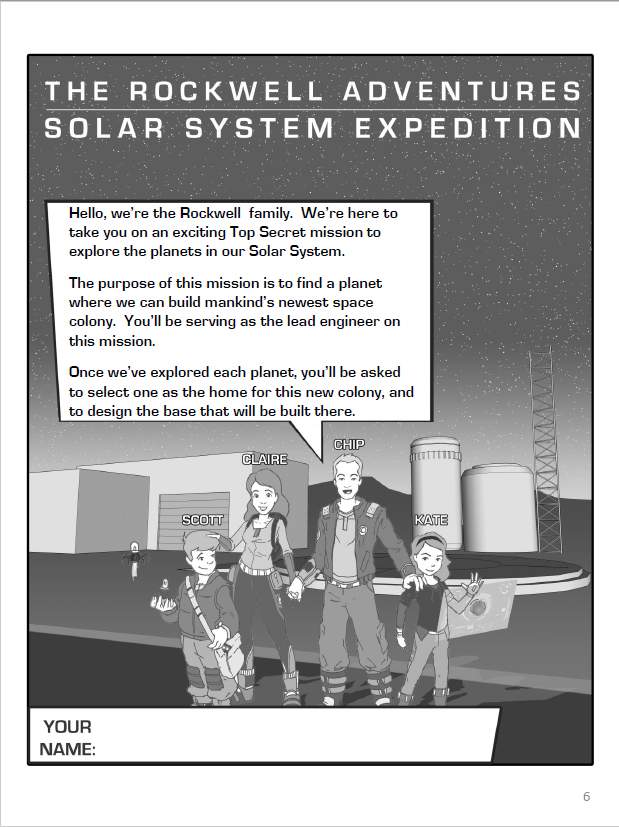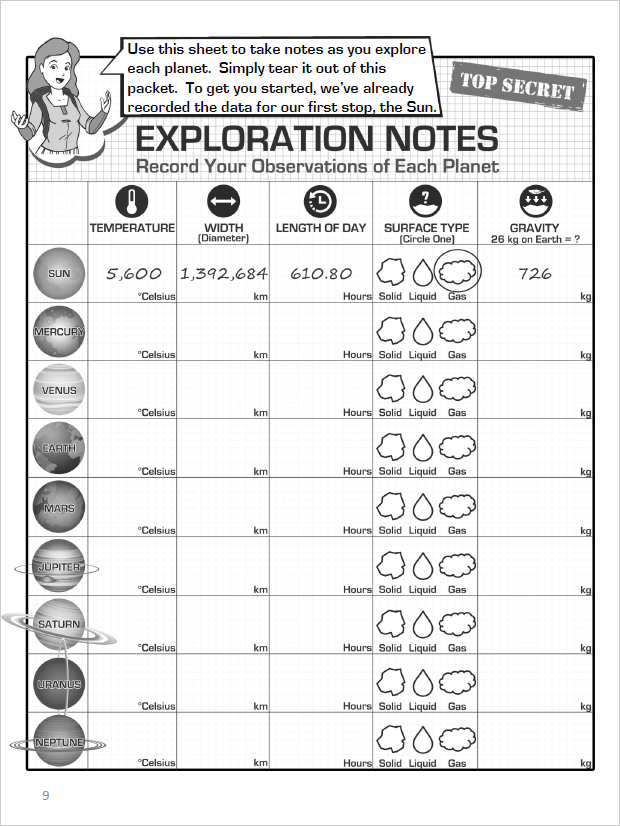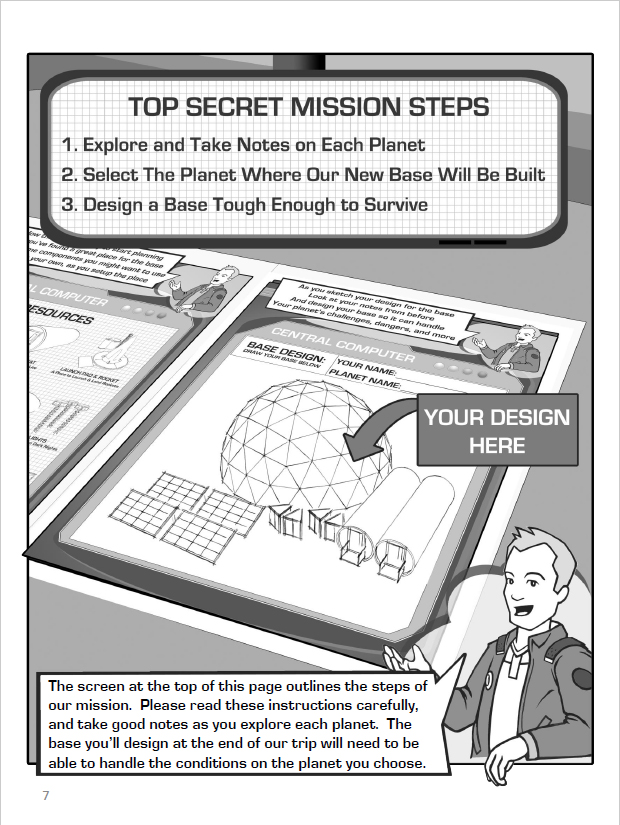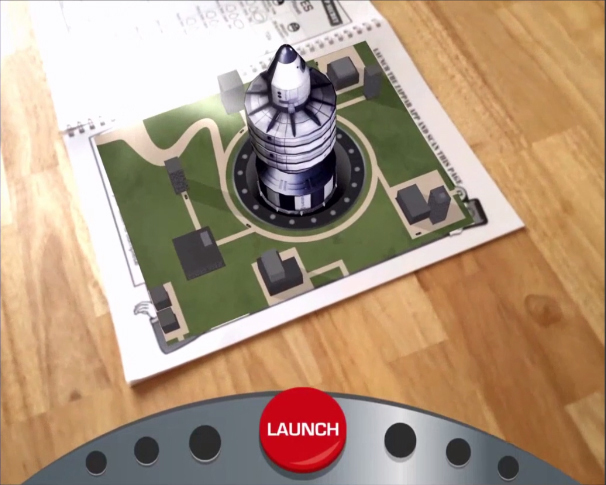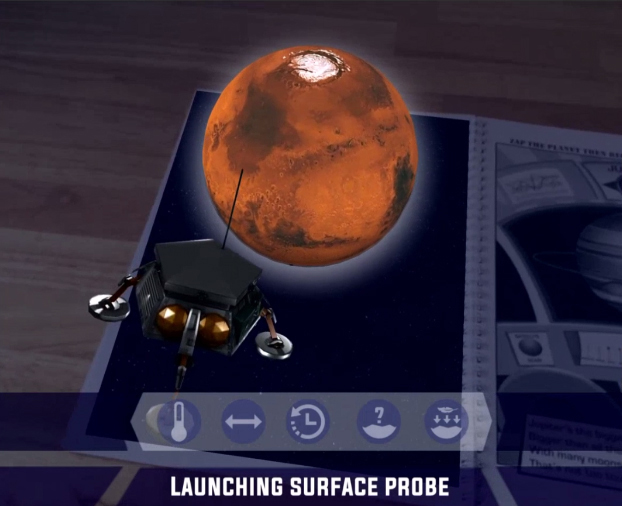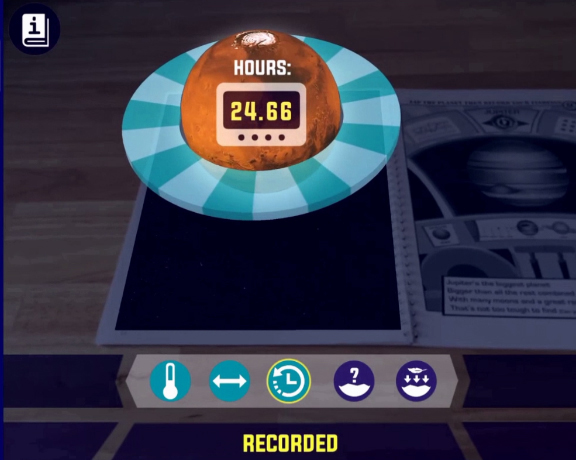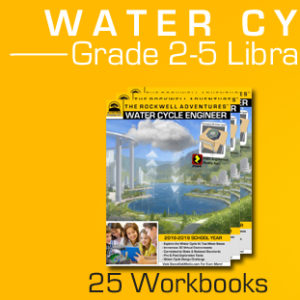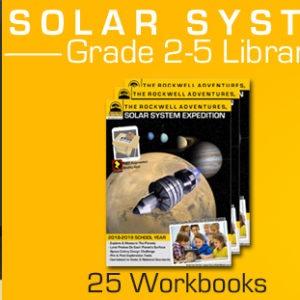January 2019
Solar System Expedition (Print Edition, Single Unit)
$19.95
Blast-off on an Augmented Reality Tour of the Solar System!
Description: Augmented reality enhanced educational activity book.
Format: Print
Quantity: 1 Book
Units Used Within Lesson: Metric Units
Time to Complete: Approximately 1 hour
Expiration: Augmented Reality content within this workbook has no set expiration date.
Description
Customer Reviews
Customer Reviews
Note: To write a review, complete the form at the bottom of this page.
Middle School Teacher in Chicago
We’ve been using this lesson in our class for about 4 years, even during the pandemic. It really is the easiest way to teach students about the Solar System. The students also always get so excited about the design portions. Keep the great products coming!
Produto excelente!
Usei a demonstração gratuita e adorei!! Ótima experiência para os alunos!! Parabéns!
(Translation: I used the free demo and loved it!! Great experience for students!! Congratulations!)
Fantastic Lesson
Primary teacher in Sydney Australia here. My students love this lesson! We’ve used it for several years now, and the students get so excited about learning. We just ordered the Water Cycle books, and can’t wait to try them!
Sugestão
Brazil: Já usei o modelo gratuito com meus alunos e adorei! Gostaria que houvessem mais opções de usar gratuitamente nas escolas públicas do interior
(I’ve used the free template with my students and I loved it! I wish there were more options to use for free in public schools in the interior)
Thank You!!!
Thank you StoneOak Media, for making amazing science products like this available for FREE during the CV-19 crisis. My students, all of who are now learning remotely, have really taken learning to the next level with this book, and Water Cycle Engineer. They’ve been so EXCITED, when I speak with them after these lessons. THANK YOU!!!
Test Drive The Mars Tour!
On the page shown below, students are asked to measure various aspects of the planet Mars. Once completed, these measurements are then recorded by the students within the “Exploration Notes” page of the workbook (shown above). At the end of the overall lesson/mission, students are then asked to use these measurements and others as a guide to help them determine which planet they would like to build a base on. Once they’ve selected a planet, these measurements then serve as a guide to help students build the right kind of base.
To try this experience for yourself, simply install the FREE Zappar app (iOS / Android) on a tablet or smartphone, and follow these simple directions:

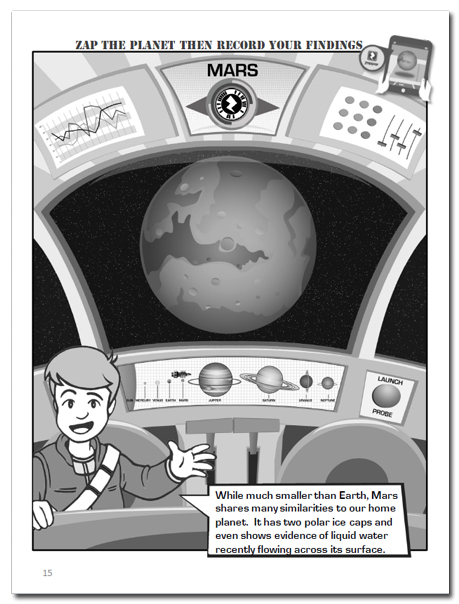
Interior pages within the workbook are illustrated in grayscale for easy classroom reproduction
Curriculum Standards Alignment
K – 2nd Grade:
- – K-2-ETS1-1 Engineering Design: Ask questions, make observations, and gather information about a situation people want to change to define a simple problem that can be solved through the development of a new or improved object or tool.
- – K-2-ETS1-2 Engineering Design: Develop a simple sketch, drawing, or physical model to illustrate how the shape of an object helps it function as needed to solve a given problem.
- – 1-ESS1 Earth’s Place in the Universe: Use observations of the sun, moon, and stars to describe patterns that can be predicted
Grade 3:
- – 3-5-ETS1-1 Engineering Design: Define a simple design problem reflecting a need or a want that includes specified criteria for success and constraints on materials, time, or cost.
- – 3-5-ETS1-2 Engineering Design: Generate and compare multiple possible solutions to a problem based on how well each is likely to meet the criteria and constraints of the problem.
Grade 4:
- – 3-5-ETS1-1 Engineering Design: Define a simple design problem reflecting a need or a want that includes specified criteria for success and constraints on materials, time, or cost.
- – 3-5-ETS1-2 Engineering Design: Generate and compare multiple possible solutions to a problem based on how well each is likely to meet the criteria and constraints of the problem.
Grade 5:
- – 3-5-ETS1-1 Engineering Design: Define a simple design problem reflecting a need or a want that includes specified criteria for success and constraints on materials, time, or cost.
- – 3-5-ETS1-2 Engineering Design: Generate and compare multiple possible solutions to a problem based on how well each is likely
Middle School (6-8)
-
- – MS-ESS1-3 Earth’s Place in the Universe: Analyze and interpret data to determine scale properties of objects in the solar system.
-
- – MS-ETS1-1 Engineering Design: Define the criteria and constraints of a design problem with sufficient precision to ensure a successful solution, taking into account relevant scientific principles and potential impacts on people and the natural environment that may limit possible solutions.
-
- – MS-ETS1-2 Engineering Design: Evaluate competing design solutions using a systematic process to determine how well they meet the criteria and constraints of the problem.
- – MS-ETS1-3 Engineering Design: Analyze data from tests to determine similarities and differences among several design solutions to identify the best characteristics of each that can be combined into a new solution to better meet the criteria for success
Grade 1:
- – 112.12 (2) Scientific Investigation & Reasoning: (a) Collecting data and making simple observations, (c) record and organize data, (e) communicate observations
- – 112.12 (4) Scientific Investigation & Reasoning: (a) collect, record, and compare information using tools, including computers, primary balances, notebooks, timers, thermometers.
- – 112.12 (5) Matter & Energy: (a) classify objects by observable properties such as larger and smaller, heavier and lighter
Grade 2:
- – 112.13 (2) Scientific Investigation & Reasoning: (a) collect data from observations using balances, thermometers,, (d) record and organize data using pictures, numbers, and words, (e) communicate observations
- – 112.13 (3) Scientific Investigation & Reasoning: (a) identify and explain a problem and propose a solution.
- – 112.13 (4) Scientific Investigation & Reasoning: (a) collect, record, and compare information using tools, including computers, rulers, primary balances, notebooks,; timing devices, including stopwatches; weather instruments such as thermometers
- – 112.13 (5) Matter & Energy: (a) classify matter by physical properties, including relative mass, relative temperature, and whether material is a solid or liquid;
Grade 3:
- – 112.14 (2): Scientific Investigation & Reasoning: (a) Using equipment to solve problems, (b) collecting data, (c) graphing data, (d) analyze data, (f) communicate conclusion
- – 112.14 [4]: Scientific Investigation & Reasoning: (a) Collect, record, analyze data using cameras, computers, metric rulers, thermometers, Sun, Earth, Moon system models, timing devices
- – 112.14 [5]: Matter & Energy: [a] measure, test, and record physical properties of matter, including temperature, mass, [b] classify matter
- – 112.14 [8]: Earth & Space: [d] Identify planets in the Solar System
- – 112.14 [9]: Organisms & Environment: Observe and describe the physical characteristics of environments and how they support populations and communities within an ecosystem;
Grade 4:
- – 112.15 (2): Scientific Investigation & Reasoning: (b) collect and record data by observing and measuring, using the metric system, and using descriptive words and numerals such as labeled drawings, writing. (c) construct simple tables, charts, bar graphs. (d) analyze data and interpret patterns. (f) communicate validresults supported by data.
- – 112.15 (2): Scientific Investigation & Reasoning: Collect, record, analyze data using cameras, computers, metric rulers, thermometers, Sun, Earth, Moon system models, timing devices
- – 112.15 [5]: Matter & Energy: (a)measure, compare, and contrast physical properties of matter, including size, mass, volume, states (solid, liquid, gas), temperature,
Grade 5:
- – 112.16 (2): Scientific Investigation & Reasoning: (c) Collect information by detailed observations and accurate measuring. (g) construct appropriate simple graphs, tables to organize, examine, and evaluate information.
- – 112.16 [6]: Scientific Investigation & Reasoning: (a) Collect, record, analyze data using cameras, computers, metric rulers, thermometers, Sun, Earth, Moon system models, timing devices
- – 112.16 [5]: Matter & Energy: [a] classify matter based on physical properties, including mass and physical state (solid, liquid, and gas).
- – 112.16 [8]: Earth & Space: [d] identify and compare the physical characteristics of the Sun, Earth
Grade 6:
- – 112.18 (2) Scientific Investigation & Reasoning: (a) collect and record data using the International System of Units (SI) and qualitative means such as labeled drawings, writing, and graphic organizers; (D) construct tables and graphs, using repeated trials and means, to organize data and identify patterns; and (E) analyze data to formulate reasonable explanations, communicate valid conclusions supported by the data, and predict trends.
- – 112.18 (4) Scientific Investigation & Reasoning: (a) collect, record, and compare information using tools, including computers, rulers, primary balances, notebooks,; timing devices, including stopwatches; weather instruments such as thermometers
- – 112.18 (6) Earth & Space: (a) describe the physical properties, locations, and movements of the Sun, planets. (c) describe the history and future of space exploration, including the types of equipment and transportation needed for space travel.
Grade 7:
- – 112.19 (2) Scientific Investigation & Reasoning: (b) collect and record data using the International System of Units (SI) and qualitative means such as labeled drawings, writing, and graphic organizers; (d) construct tables and graphs, using repeated trials and means, to organize data and identify patterns; and (e) analyze data to formulate reasonable explanations, communicate valid conclusions supported by the data, and predict trends.
- – 112.19 (8) Earth & Space: The student knows components of our solar system. The student is expected to (a) analyze the characteristics of objects in our solar system that allow life to exist such as the proximity of the Sun, presence of water, and composition of the atmosphere; and (B) identify the accommodations, considering the characteristics of our solar system, that enabled manned space exploration.
Grade 8:
-
- – 112.20 (2): Scientific Investigation & Reasoning: (c)collect and record data using the International System of Units (SI) and qualitative means such as labeled drawings, writing, and graphic organizers; (d) construct tables and graphs, using repeated trials and means, to organize data and identify patterns; and (e) analyze data to formulate reasonable explanations, communicate valid conclusions supported by the data, and predict trends.
- – 112.20 [4]: Scientific Investigation & Reasoning: (a) use appropriate tools to collect, record, and analyze information, including lab journals/notebooks, meter sticks, balances, thermometers, computers, timing devices, and other equipment as needed to teach the curriculum
Grade 2:
Physical Science: Properties of Matter
– 2.P.8.1: Observe and measure objects in terms of their properties, including size, shape, color, temperature, weight, texture, sinking or floating in water, and attraction and repulsion of magnets.
– 2.P.8.2: Identify objects and materials as solid, liquid, or gas.
Nature of Science: The Practice of Science
– 2.N.1.1: Raise questions about the natural world, investigate them in teams through free exploration and systematic observations, and generate appropriate explanations based on those explorations.
Grade 3:
Physical Science: Properties of Matter
– 3.P.8.1: Measure and compare temperatures of various samples of solids and liquids.
– 3.P.8.3: Compare materials and objects according to properties such as size, shape, color, texture, and hardness.
Nature of Science: The Practice of Science
– 3.N.1.1: Raise questions about the natural world, investigate them individually and in teams through free exploration and systematic investigations, and generate appropriate explanations based on those explorations.
– 3.N.1.3: Keep records as appropriate, such as pictorial, written, or simple charts and graphs, of investigations conducted.
Grade 5:
Physical Science: Properties of Matter:
– 5.P.8.1: Compare and contrast the basic properties of solids, liquids, and gases, such as mass, volume, color, texture, and temperature.
Earth and Space Science: Earth in Space and Time
– SC.5.E.5.2: Recognize the major common characteristics of all planets and compare/contrast the properties of inner and outer planets.
Nature of Science: The Practice of Science
– 5.N.1.1: Define a problem, use appropriate reference materials to support scientific understanding, plan and carry out scientific investigations of various types such as: systematic observations, experiments requiring the identification of variables, collecting and organizing data, interpreting data in charts, tables, and graphics, analyze information, make predictions, and defend conclusions.
Grade 8:
Earth and Space Science: Earth in Space and Time
– 8.E.5.3: Distinguish the hierarchical relationships between planets and other astronomical bodies relative to solar system, galaxy, and universe, including distance, size, and composition.
Write a Review
Write a Review
Note: Reviews are typically published within 24 hours of submission.
Related Professional Development Classes
Related Professional Development Classes
There are no upcoming events at this time



